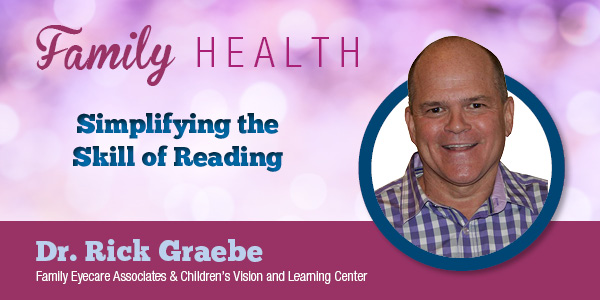Simplifying the Skill of Reading
Reading may seem like a natural skill, but the demands it places on the visual system are surprisingly complicated.
That’s why for some students, reading is a struggle.
Our eyes are designed to look straight ahead at a three-dimensional world, but the demands of school force students to spend up to 75% of their time in close-up work, looking at two-dimensional words on the page or computer screen.
For those who struggle to make that adaptation, the problem begins with the way the eyes move, according to Dr. Rick Graebe, a behavioral optometrist in Versailles.
The eyes must first must converge, or turn in and focus, and then move along the line of the page while we hear the words in our head and visualize what they mean.
Although these things happen simultaneously for the capable reader, breakdowns in any area can make reading difficult.
People who struggle to read may have problems tracking or following the words along the line, and find it difficult to jump to the next line when they reach the end.
Dr. Graebe and his Vision Therapists in Versailles can administer a test to determine if a person is reading smoothly.
For those who are struggling, Dr. Graebe has several solutions. First, patients can undergo training that will teach their brains to overcome convergence insufficiency to give them more control over their eyes.
Dr. Graebe also offers stress lenses in glasses that help the eyes focus so they don’t have to turn in as far to read.
Stress lenses can take stress off the eye and help prevent nearsightedness. They also can create dramatic changes for many slow or choppy readers.
“Sometimes the difference is like night and day,” Dr. Graebe says.
“A child will read with difficulty, then put on the stress lenses and immediately read smoothly. Parents look at me and say, ‘Are you kidding me?’ It can seem like magic to them.”
Vision Therapy also can train the eyes to track words more efficiently as they read across a page through sequential exercises, taking patients through the four steps of skill mastery.
First, patients are unconscious that a problem exists. Once they learn otherwise, step two, “That’s when learning takes place,” Dr. Graebe says.
Third, the reader learns to consciously make corrections. And the fourth and final step is unconscious mastery of the skill. That’s when reading becomes second nature.
“When that happens,” Dr. Graebe says, “that’s what makes my job so gratifying.”

